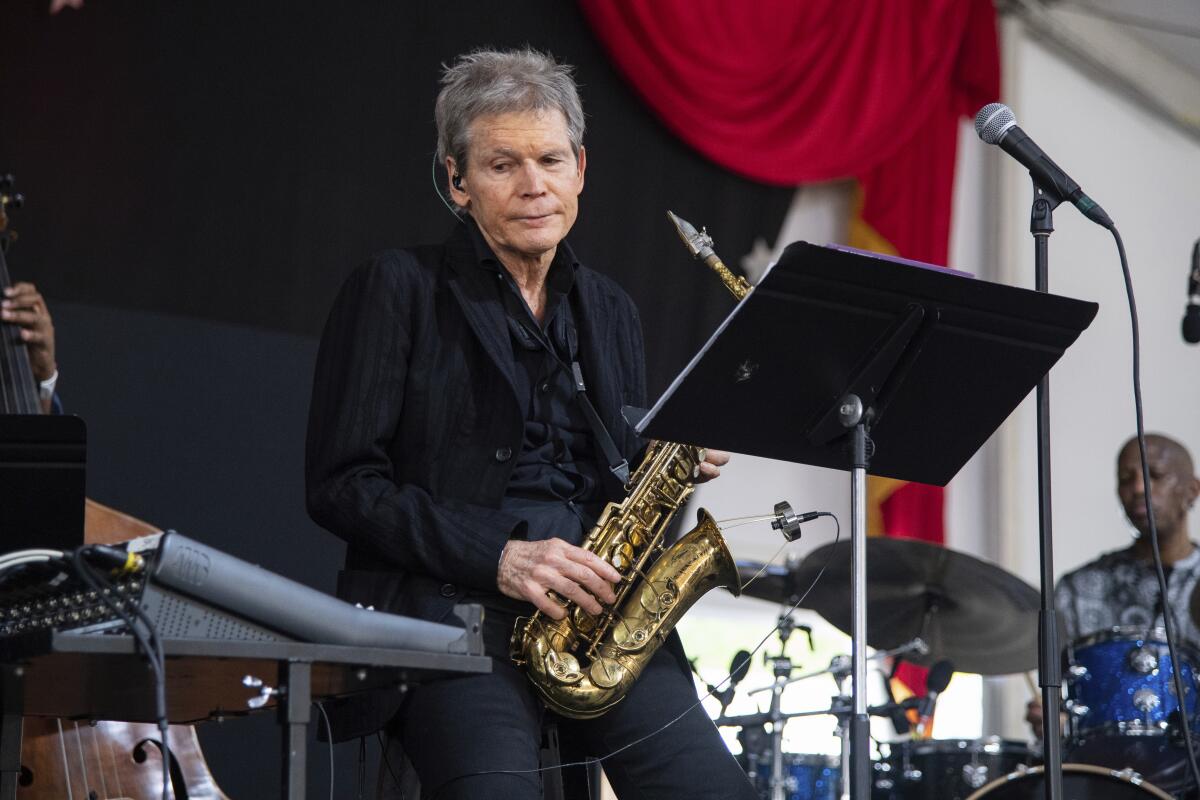David Sanborn, the influential saxophonist whose Grammy-winning career included collaborations with Stevie Wonder and David Bowie, has died. He was 78.
Sanborn died Sunday afternoon “after an extended battle with prostate cancer with complications,” his team said Monday in an announcement shared to his social media pages. A representative for Sanborn confirmed the details to The Times.
“Mr. Sanborn had been dealing with prostate cancer since 2018, but had been able to maintain his normal schedule of concerts until just recently,” his team said in an X (formerly Twitter) thread. “Indeed he already had concerts scheduled into 2025.”
Sanborn was known for luxurious saxophone melodies on songs including “Maputo,” but his sound — informed by R&B and global funk— and his legacy extended far beyond his jazz roots. Often perceived as a “smooth jazz” artist, Sanborn loathed that term.
“I sometimes get looped in with jazz musicians because I play sax and improvise,” Sanborn told The Times in 1996. “But if you know my music, you wouldn’t confuse it with jazz. There are certain stylistic and rhythmic elements that keep me from being in that category.”
Sanborn’s vast roster of elite session work and high-profile collaborators proved his range of influences. Stevie Wonder, the Rolling Stones and David Bowie were among Sanborn’s collaborators early in his career. After going solo in 1975, Sanborn worked with musicians including Paul Simon, James Taylor, Luther Vandross and Eric Clapton, according to his website.
Among pop and R&B fans, Sanborn is best known for his work on Wonder’s “Talking Book,” Bowie’s “Young Americans” and records by Bonnie Raitt and Chaka Khan.
Over the course of his career, Sanborn earned 16 Grammy Award nominations and six wins, including honors for his albums “Straight to the Heart” and “Double Vision,” a collaboration with keyboardist Bob James. Sanborn released 25 albums, including eight that went gold and one that achieved platinum status.
“David Sanborn was a seminal figure in contemporary pop and jazz music,” Monday’s statements added. “It has been said that he ‘put the saxophone back into Rock ’n Roll.’”

David Sanborn, pictured at the 2022 New Orleans Jazz and Heritage Festival, was “a seminal figure in contemporary pop and jazz music,” his team said in a statement.
(Amy Harris / Invision / Associated Press)
Sanborn’s passion for the saxophone can be traced back to his childhood. Born in 1945 in Tampa, Fla., he contracted polio as a toddler and music was part of his treatment. By the time he graduated from the University of Iowa, Sanborn had played with guitarist Albert King and studied with studied saxophonist J.R. Monterose.
After joining the Paul Butterfield Blues Band in the 1960s (he performed with them at Woodstock), Sanborn began a long, fruitful partnership with Miles Davis’ arranger Gil Evans. Then in 1975, the release of “Taking Off” marked the beginning of Sanborn’s solo career.
His 1980 LP “Hideaway” was steeped in funk and raw production (the track “The Seduction” was a theme for the film “American Gigolo”) and kicked off a decade-long bestseller streak that included 1981’s “Voyeur” and “As We Speak,” 1983’s “Backstreet,” 1984’s live LP “Straight to the Heart” and 1988’s “Close Up,” which incorporated electronics.
In 1991, Sanborn released “Another Hand,” perhaps his most beloved album among core jazz traditionalists. The project featured an incendiary band with Bill Frisell, Charlie Haden and Marc Ribot. Later in his career, Sanborn returned to his genre-expansive roots on albums like 2015’s “Time and the River,” an acclaimed LP that spanned Latin, African and soul rhythms. “This Masquerade,” released in 2018, was Sanborn’s most recent solo album.
For the record:
12:07 p.m. May 14, 2024An earlier version of this story said “Night Music,” also known as “Sunday Night Live,” was broadcast from 1998 to 1990. It ran from 1988 to 1990.
Beyond music, Sanborn pursued a variety of TV and film opportunities. From 1988 to 1990, he and pianist Jools Holland co-hosted the late-night TV series “Night Music” (also known as “Sunday Night Live”), which platformed musicians including Sonny Rollins, Sun Ra and Sonic Youth. That show was produced by “Saturday Night Live” creator Lorne Michaels.
He regularly hosted the “After New Year’s Eve” TV special on ABC and fronted his own syndicated jazz program. The saxophonist wrote scores for the “Lethal Weapon” film franchise and frequently joined David Letterman’s live band. He also hosted the podcast “As We Speak” from WBGO Studios.
Sanborn, who channeled and contributed to a wide range of genres and mediums, brushed off the need for labels during his 1996 interview with The Times
“If you shut out music because it doesn’t fit your preconceived listening patterns, you’re cheating yourself,” he said. “Opera, country, outside music, commercial music … if you like it, it’s good. If it has meaning, use it.”
Sanborn is survived by his wife, Alice Soyer Sanborn, their son, Jonathan Sanborn, and daughter-in-law, Rosie Sanborn. Survivors also include two granddaughters, his sisters Sallie Sanborn and Barb Sanborn, brother-in-law Steve Friedman and nephew Noah Friedman. Donations in Sanborn’s memory can be made to St. Jude Children’s Research Hospital.
Times staff writer August Brown contributed to this report.

